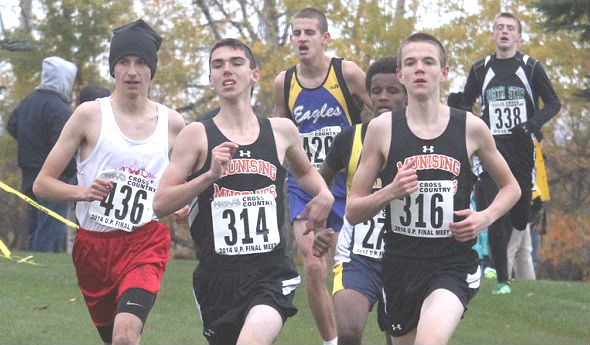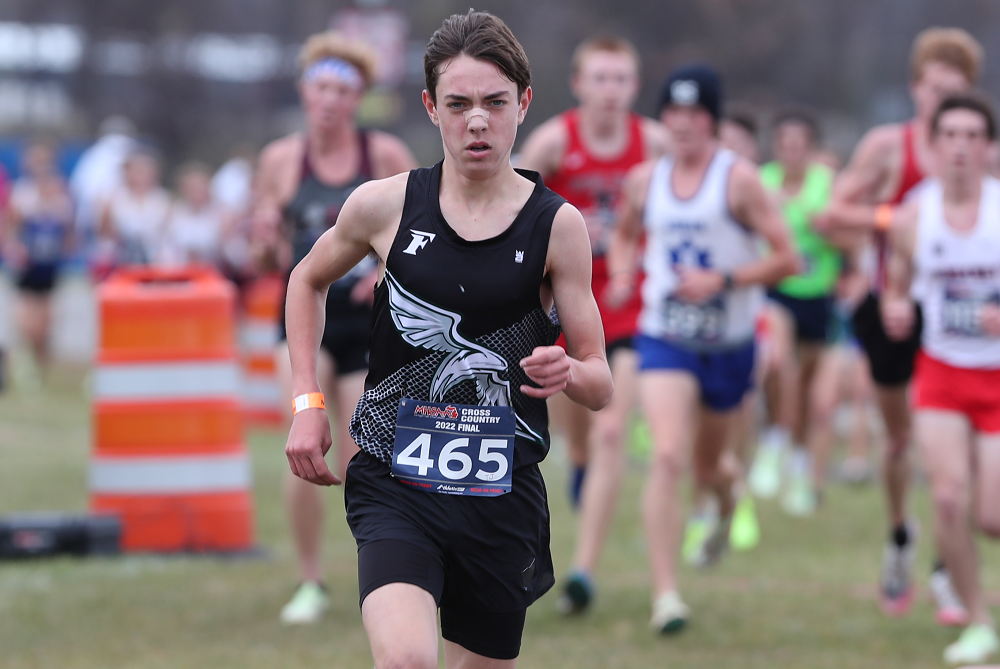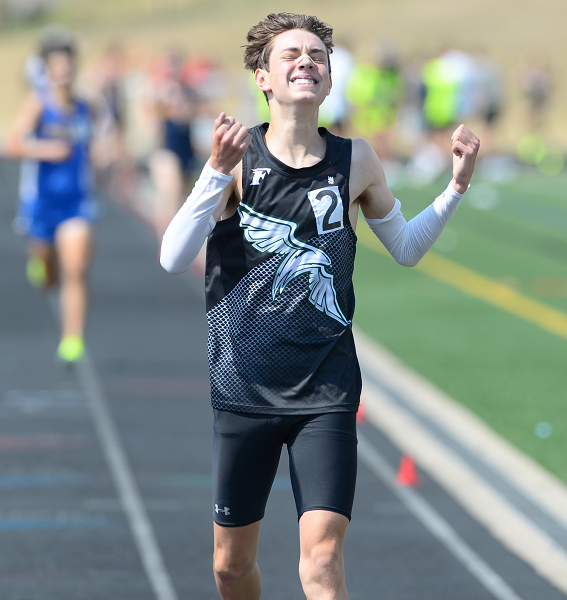
Opportunities Abound for New Winners
October 23, 2015
By Geoff Kimmerly
Second Half editor
Saturday’s MHSAA Upper Peninsula Cross Country Finals at Beauchamp Grove in Gladstone, sponsored by Michigan National Guard, should provide the ideal scenarios to crown first-time champions.
While Chassell is the favorite in Division 3 after winning a year ago, neither Bessemer nor Wakefield-Marenisco has won an MHSAA boys cross country title – and together they are the favorite in Division 2. Negaunee is top-ranked in Division 1 and hasn’t won in more than 30 years. And only one of three individual champions is back to chase another title.
Here's a look at some of the teams and individuals expected to contend in all three races. Click for Saturday's race schedule and a list of all qualifiers.
DIVISION 1
Reigning champion: Marquette
2014 runner-up: Escanaba
2015 top three: 1. Negaunee, 2. Marquette, 3. Escanaba.
Negaunee’s last boys cross country championship came in 1983, but the Miners are favored to return to the top with all seven runners back from last season’s fifth-place team. Senior Grant Johnson and sophomore Colton Yesney were the top finishers in 2014, at 10th and 11th, respectively. Marquette returns only two runners from last season and has added three freshmen to four seniors – but those two returnees are senior Lance Rambo, last year’s runner-up, and senior Troy Sergey, who was 13th. Escanaba also returns only two runners from last season’s lineup, but junior Joey Wolfe was third individually and senior Jon Hook was 16th.
Individuals: The top three finishers from last year should pace the field again, with Rambo and Wolfe joined by reigning champion Nate Carey. The Kingsford senior finished third behind both at the Great Northern Conference final last week. Calumet junior Mitchell DeLong was 12th last season, and Kingsford senior Jorge Sanchez came in 14th.
DIVISION 2
Reigning champion: Ishpeming
2014 runner-up: Powers North Central
2015 top three: 1. Gogebic, 2. Ishpeming, 3. Powers North Central.
Neither Bessemer nor Wakefield-Marenisco had enough runners to compete in Division 3 as a team last season, but as a co-op in Division 2 they've combined to make favorite Gogebic. Senior Sam Dean was fifth last season in Division 3 and sophomore Tim Rowe finished 20th. Four of the top five Hematites finishers are back; senior Kazmine Langness was third last season, while senior Derek Mahoski was 11th, sophomore Kyle Pruett was 12th and junior Matthew Ferrett was 14th. Powers North Central finished only 14 points back of Ishpeming and returns six runners led by runner-up Bryce Holle, now a senior, seventh-place junior Seth Polfus, 16th-place sophomore Connor Robinson and 19th-place senior Jared Gerlach.
Individuals: Total, 10 of last season’s top 15 are back – although two-time champion Jared Joki of Ironwood graduated. Manistique sophomore Phillip Hagenson finished fourth in 2014, while Hancock junior Murphy Mallow is back after finishing seventh. Ironwood does return a pair of standouts – sophomore Andrew Niemi was ninth last season and senior Tim Lorenson was 11th.
DIVISION 3
Reigning champion: Chassell
2014 runner-up: Stephenson
2015 top three: 1. Chassell, 2. Munising, 3. Dollar Bay.
Chassell is a solid favorite returning all seven runners from last year’s team that won by six points. Four runners finished among the top 20 – now-freshman Abraham Gockenbach was fourth, junior Hunter Rautiola was ninth, senior Lars Daavettila was 14th and freshman Ben Tuomi was 16th. Munising was third last season and returns four of its top five including senior third-place finisher Brett Hannah. Senior Kyle LeClaire leads a Dollar Bay team returning five of seven from last year’s fourth-place team; LeClaire was sixth and sophomore Devin Schmitz finished 17th.
Individuals: Although the top two finishers from 2014 are not back, nine of the top 15 will run. In addition to those mentioned above, Stephenson sophomore Ethan Brown was seventh last season, Cedarville senior Patrick McMaken was 10th and junior Avry Freel was 15th, Big Bay de Noc sophomore Lucas Sundling was 13th and Eben Junction Superior Central junior Luke Leppanen was 14th.
PHOTO: Munising’s Brett Hannah ended third in the U.P. Division 3 race last season and returns as the highest finisher back from that field.

Freeland's Hansen Not Focused on Joining All-Time Greats - But On His Way
By
Paul Costanzo
Special for MHSAA.com
September 29, 2023
The goal written on Matt Kaczor’s Post-It Note was sub-15 minutes, 15 seconds. That’s what the Freeland cross country coach was hoping for from star runner TJ Hansen during his junior season.
 Kaczor tore it up after seeing Hansen run a single race this fall.
Kaczor tore it up after seeing Hansen run a single race this fall.
“Knowing what he did over the summer and where he was at, seeing what his 1,600 (meter) and his mile got down to, I had a feeling he could get under 15:30 quickly,” Kaczor said. “After the first race, I looked at my assistant and was like, ‘I’ve gotta rip up that Post-It Note. I don’t think our goal is on the level of where he’s at right now.’ At first, it was break 15:15. Once I saw him race at the Under the Lights (on Aug. 18 at St. Johns), I was like, ‘Yeah, he’s going sub 15.’”
Hansen ran 15:39.6 in that first race, and on Sept. 7, in Shepherd, he ran 15:13.9 to meet the goal written on the now-shredded Post-It Note.
This past Saturday, he ran 15:03.7 at the Cadillac Veterans Serving Veterans Invitational. It’s the fastest time recorded in Michigan this year, and a signal that Kaczor might be filling out a new Post-It Note before the season is out.
“The sub-15 barrier, that’s been something on my mind for a while,” Hansen said. “Now that I’m edging closer and closer to that, it’s been exciting. With how heavy my training has been, I wouldn’t expect (to have run this fast this early). Being able to run the times I am really paints the picture for what’s ahead.”
Hansen came into the season already regarded as one of the elite distance runners in the state. He won the 3,200 meters at the MHSAA Lower Peninsula Division 2 Track & Field Finals this past spring. He’s also finished all-state (12th and fifth, respectively) the past two seasons at the LPD2 Cross Country Finals.
His current trajectory, however, would put his name near some of the state’s all-time greats. But that’s not something Hansen is focusing on.
“I really don’t like to compare myself to others,” he said. “I don’t focus on that. I try to be the best TJ Hansen that I can be. The best version of myself.”
Focusing on himself is almost necessary for Hansen, as he’s spending a lot of time during his races running by himself.
At each of the big events Freeland has run in this season, Hansen has finished at least 20 seconds ahead of his nearest competitor. That includes all divisions of the Duane Raffin Festival of Races in Holly.
In Cadillac, where Hansen ran his current best time, he was a full minute ahead of the rest of the field.
 “He’s just a special athlete,” Kaczor said. “I can’t see Freeland having someone like this in a while. He’s a generational talent. What’s crazy is, I had the school record when he was a freshman. He and Braden (Honsinger) broke it last year. But TJ has now dropped that school record (set in 1998) by almost a minute.”
“He’s just a special athlete,” Kaczor said. “I can’t see Freeland having someone like this in a while. He’s a generational talent. What’s crazy is, I had the school record when he was a freshman. He and Braden (Honsinger) broke it last year. But TJ has now dropped that school record (set in 1998) by almost a minute.”
Hansen’s achievements have already put him on a path to run at the next level, which is something of a family tradition.
His older sisters Peyton and Kiera are track & field athletes at Wayne State and Eastern Michigan, respectively. Their parents, Tim and Pam, were track & field stars at Central Michigan.
TJ has drawn the attention of coaches around the country, including from Michigan, Michigan State, Wisconsin, Tennessee and Colorado.
Having family members who know the process is a help for Hansen, and he said they’ve all been good about allowing him to choose his own path, whatever that may be.
“He’s from a good family that knows how to work and knows how to get things done,” Kaczor said. “He knows that if he puts in the work, he’s going to be at a good spot.”
While Hansen admits it can be a bit overwhelming, he’s using it as motivation to run faster and continue to put his name out there.
Also serving as motivation is 2022 Division 2 champion Connell Alford of Chelsea. Alford is among the elite group of runners in Michigan who have broken the 15-minute mark, doing it twice a year ago.
He currently has the state’s second-best time behind Hansen’s this year, running 15:09.1 at the MSU Invitational on Sept. 15.
“Whenever I see him drop a time, my main goal is to run faster,” Hansen said. “Whenever I see him run a good time, that motivates me to work hard.”
The two won’t see each other until the MHSAA Finals on Nov. 4 at Michigan International Speedway. It’s an opportunity Hansen is excited for, as it’s a chance to race and be pushed toward the lofty goals he’s set for himself. Kaczor is excited about it, too, even if it might mean having to replenish his supply of Post-Its.
“We don’t talk about winning the state title; we talk about making sure that we have great races on those days,” Kaczor said. “We can’t control how somebody else runs. It’s a matter of can we, if the weather is right and the course is in good condition, can we be one of the few guys that has run in the 14s on that course? That’s the goal. Put yourself in some great categories with those upper echelons and the greats of all-time.”
 Paul Costanzo served as a sportswriter at The Port Huron Times Herald from 2006-15, including three years as lead sportswriter, and prior to that as sports editor at the Hillsdale Daily News from 2005-06. He can be reached at [email protected] with story ideas for Genesee, Lapeer, St. Clair, Sanilac, Huron, Tuscola, Saginaw, Bay, Arenac, Midland and Gladwin counties.
Paul Costanzo served as a sportswriter at The Port Huron Times Herald from 2006-15, including three years as lead sportswriter, and prior to that as sports editor at the Hillsdale Daily News from 2005-06. He can be reached at [email protected] with story ideas for Genesee, Lapeer, St. Clair, Sanilac, Huron, Tuscola, Saginaw, Bay, Arenac, Midland and Gladwin counties.
PHOTOS (Top) Freeland's TJ Hansen leads a pack during last season's LPD2 Final at Michigan International Speedway. (Middle) Hansen enjoys a moment of exhilaration after winning the 3,200 this spring at the LPD2 Finals at Ada Forest Hills Eastern. (Top photo by Carter Sherline/Run Michigan; middle photo by Dave McCauley/Run Michigan.)

